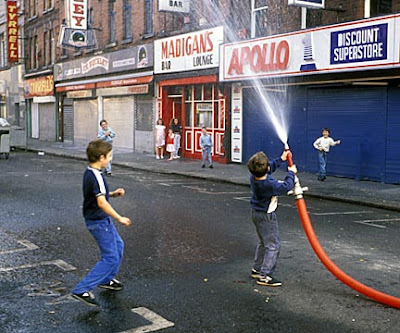 Questions, questions
Questions, questionsMy students ask all these questions when I suggest we go out and take pictures of people in the street. Some have to make a great effort to pluck up enough courage just to take the camera of the bag. Usually it does not take them long to see how much fun it is and how good the rapport can be with total strangers.
Here are five questions I am asked most often...
Q
Will people object to being photographed?
A
Well, I suppose you can make a friend or a foe in 1/500sec, but mostly people will either ignore you altogether, or ask why you are taking their picture. A perfectly reasonable question that deserves an answer. The amateur photographer has got the ideal reply – “I’m just a keen photographer who enjoys photographing people, I hope you don’t mind.”
Q
Will they become aggressive?
A
Very, very rarely. Common sense and basic street craft comes into play here and you will soon learn when to leave the camera in the bag. If someone tells you to ‘go away’, just smile and go, don’t argue, there are plenty of other subjects to choose from.
Q
Should you ask permission first?
A
I nearly always prefer to get something in the can and ask permission afterwards. Again, much depends on the circumstances, but remember, when someone says they don’t mind being photographed, you might have a ‘tame’ subject and you should ask to take more pictures.
Q
What should you do if they spot you taking their picture?
A
Take another picture – often the reaction to being photographed can create a very special photograph. Then smile broadly, hold both hands up and tell them what you are doing and why.
Q
Will people object to being photographed?
A
Well, I suppose you can make a friend or a foe in 1/500sec, but mostly people will either ignore you altogether, or ask why you are taking their picture. A perfectly reasonable question that deserves an answer. The amateur photographer has got the ideal reply – “I’m just a keen photographer who enjoys photographing people, I hope you don’t mind.”
Q
Will they become aggressive?
A
Very, very rarely. Common sense and basic street craft comes into play here and you will soon learn when to leave the camera in the bag. If someone tells you to ‘go away’, just smile and go, don’t argue, there are plenty of other subjects to choose from.
Q
Should you ask permission first?
A
I nearly always prefer to get something in the can and ask permission afterwards. Again, much depends on the circumstances, but remember, when someone says they don’t mind being photographed, you might have a ‘tame’ subject and you should ask to take more pictures.
Q
What should you do if they spot you taking their picture?
A
Take another picture – often the reaction to being photographed can create a very special photograph. Then smile broadly, hold both hands up and tell them what you are doing and why.
Q
May I publish a photograph I've taken of someone in the street?
A
Yes. Provided the photograph is not detrimental in any way to the person's character of good name. If you use the photograph for advertising purposes, that person may have a legitimate complaint.

TEN TIPS
Use fast shutter speeds to freeze people’s movements. 1/250sec minimum if possible. This may require a faster ISO such as 400 or 800 in poor light conditions.
Keep your camera set for instant use either with the correct exposure on Manual mode, or use TV (shutter priority mode). And keep your camera accessible – preferably around your neck and perhaps tucked into your jacket.
Be patient. Be observant and watch people closely.
Be aware of everything going on around you.
Anticipate where people are likely to go – you will learn to predict their movements quite well with practise.
Find good viewpoints and wait for people to move into them.
Start with ‘back view’ shots of people.
Take lots of pictures. That ‘decisive moment’ can be elusive.
Travel light – big, heavy camera bags are a nuisance and will attract attention.
Keep your camera bag zipped up when working in a crowded street. It would be a shame to lose equipment to light fingers while you are concentrating on taking pictures.
Top photograph
Once you have got more used to being seen about in the street with your cameras you can really start to enjoy yourself. You will find subjects everywhere. You must always be aware of what is going on around you all the time. Keep your eyes open and be prepared to move quickly into the best position when you see an interesting situation developing. Sometimes the subjects come right up to you. In this case, the two butchers were carrying their wares down a Dublin street. With the exposure already set and using a wide angle lens, all I had to do was wait until they filled the frame and press the button

Middle photograph
Towns like Cambridge are well used to people taking pictures, and chances are that you will be totally ignored when you raise the camera to your eye in a town like this. Don’t be in too much of a rush to take dramatic ‘candid’ shots of people straight away. Take it easy and slowly and concentrate on taking pictures of people who are absorbed in something else
Bottom photograph
No photographer worth his salt is going to walk away from an opportunity like this. Just keep pressing the button. With lively subjects it is always best to take lots of pictures. There is no need to interfere with what is going on – the kids are having a ball. The most important thing was to avoid a soaking from the little beggars


2 comments:
Overcoming my inhibitions about being one of the few to comment after reading :-) I found your comment on picking a location and waiting for action to move into it particularly interesting - when I started I rushed around snapping everything and got 'snapshots' until I slowed down and just watched people, places and backgrounds. I'm sure there are hundreds of other tips, none as good as giving it a go - much like leaving a comment really :-)
I've been reading more about street photography on various websites, and the range of advice and techniques on offer seems endless! One site offers advice on what to do when spotted which runs directly counter to your advice, Philip, and which makes me feel quite uncomfortable. http://candids.hervard.net/tips
Having seen both in person and photographically the success of your open, honest and friendly approach, that's certainly the way I'll be trying to improve my street photography skills. By the way, have you taken any more of that wonderful old sailor and model maker we met on the Kirkcudbright docks? Cathy.
Post a Comment